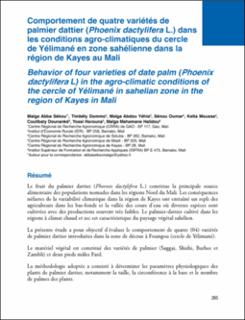| dc.contributor.author | Maïga, Abba Sékou | |
| dc.contributor.author | Timbély, Dommo | |
| dc.contributor.author | Maïga, Abdou Yéhiya | |
| dc.contributor.author | Sénou, Oumar | |
| dc.contributor.author | Keïta, Moussa | |
| dc.contributor.author | Coulibaly, Dounanké | |
| dc.contributor.author | Yossi, Harouna | |
| dc.contributor.author | Maïga, Mahamane Halidou | |
| dc.coverage.spatial | Mali | en_US |
| dc.date.accessioned | 2020-11-15T14:19:12Z | |
| dc.date.available | 2020-11-15T14:19:12Z | |
| dc.date.issued | 2020 | |
| dc.identifier.isbn | 978-99952-803-4-5 | |
| dc.identifier.uri | https://hdl.handle.net/11250/2687904 | |
| dc.description | Citation correct de ce document / Correct citation of this document: Maïga, A.S. et al. (2020). Comportement de quatre variétés de palmier dattier (Phoenix dactylifera L.) dans les conditions agro-climatiques du cercle
de Yélimané en zone sahélienne dans la région de Kayes au Mali. In: N'Diaye, I. et al. (eds.) Adaptation de l'Agriculture et de l'Élevage au Changement Climatique au Mali: Résultats et leçons apprises au Sahel. Bamako, Mali: Institut d'Economie Rurale. pp. 265-276. | en_US |
| dc.description | Le livre complet est accessible sur le site internet suivant / The complete book can be accessed from the following link https://hdl.handle.net/11250/2687372 | |
| dc.description.abstract | Résumé: Le fruit du palmier dattier (Phoenix dactylifera L.) constitue la principale source alimentaire des populations nomades dans les régions Nord du Mali. Les conséquences néfastes de la variabilité climatique dans la région de Kayes ont entraîné un repli des agriculteurs dans les bas-fonds et la vallée des cours d’eau où diverses espèces sont cultivées avec des productions souvent très faibles. Le palmier-dattier cultivé dans les régions à climat chaud et sec est caractéristique du paysage végétal sahélien.
La présente étude a pour objectif d’évaluer le comportement de quatre (04) variétés de palmier dattier introduites dans la zone de décrue à Foungou (cercle de Yélimané).
Le matériel végétal est constitué des variétés de palmier (Saggai, Shishi, Barhee et Zambli) et deux pieds mâles Fard.
La méthodologie adoptée a consisté à déterminer les paramètres physiologiques des plants de palmier dattier, notamment la taille, la circonférence à la base et le nombre de palmes des plants.
Les résultats ont montré que la variété Saggai a le plus fort taux de mortalité, 56%, suivie par la variété Shishi avec un taux de mortalité de 6%.
De même, on a observé que les paramètres physiologiques des variétés Zambli et Barhee sont meilleurs à ceux des variétés Shishi et Saggai.
De bons résultats tant au niveau de la survie que des paramètres végétatifs ont été observés au niveau des plants mâles. | en_US |
| dc.description.abstract | Abstract: The fruits of date palm trees (Phoenix dactylifera L.) are the main source of food for nomad populations in the Northern regions of Mali. The negative effects of climate variability in the region of Kayes have caused farmers to the fall back on lowlands and river valleys, where diverse species are grown often with very low yields. Date palm growing in hot and dry climate regions is typical of the Sahelian landscape.
The present study entitled “Behavior of Four Varieties of Date Palm (Phoenix dactylifera L.) in the Agro-climatic Conditions of the cercle of Yélimané in the Sahelian Zone, region of Kayes, Mali” aimed to assess the behavior of the date palm varieties introduced in Foungou (cercle of Yélimané).
The plant material was made up of four palm varieties (Saggai, Shishi, Barhee and Zambli) and two male plants (Fard).
The method adopted for the study consisted in determining the physiologic parameters of date palm plants, including the height, the circumference at the basis and the number of palms per plant.
The results show that the Saggai variety has the highest mortality rate (56%) followed by the Shishi variety with only 6%.
We also found that the physiologic parameters of the Zambli and Barhee varieties were better than those of the varieties Shishi and Saggai.
Male plants also showed a good performance in term of survival rate as well as vegetative parameters. | en_US |
| dc.language.iso | fre | en_US |
| dc.publisher | Institut d’Économie Rurale (IER), Bamako, Mali | en_US |
| dc.rights | Attribution-NonCommercial-NoDerivatives 4.0 Internasjonal | * |
| dc.rights.uri | http://creativecommons.org/licenses/by-nc-nd/4.0/deed.no | * |
| dc.subject | comportement des plants | en_US |
| dc.subject | Kayes | en_US |
| dc.subject | palmier dattier | en_US |
| dc.subject | variation climatique | en_US |
| dc.subject | plant behavior | en_US |
| dc.subject | date palm | en_US |
| dc.subject | climatic variation | en_US |
| dc.title | Comportement de quatre variétés de palmier dattier (Phoenix dactylifera L.) dans les conditions agro-climatiques du cercle de Yélimané en zone sahélienne dans la région de Kayes au Mali | en_US |
| dc.title.alternative | Behavior of four varieties of date palm (Phoenix dactylifera L) in the agro-climatic conditions of the cercle of Yélimané in sahelian zone in the region of Kayes in Mali | en_US |
| dc.type | Chapter | en_US |
| dc.type | Peer reviewed | en_US |
| dc.subject.nsi | VDP::Landbruks- og Fiskerifag: 900::Landbruksfag: 910::Planteforedling, hagebruk, plantevern, plantepatologi: 911 | en_US |
| dc.source.pagenumber | 265-276 | en_US |
| dc.relation.project | Projet Adaptation de l’Agriculture et de l’Élevage au Changement Climatique / Adaptation of Agriculture and Livestock to Climate Change project | en_US |

